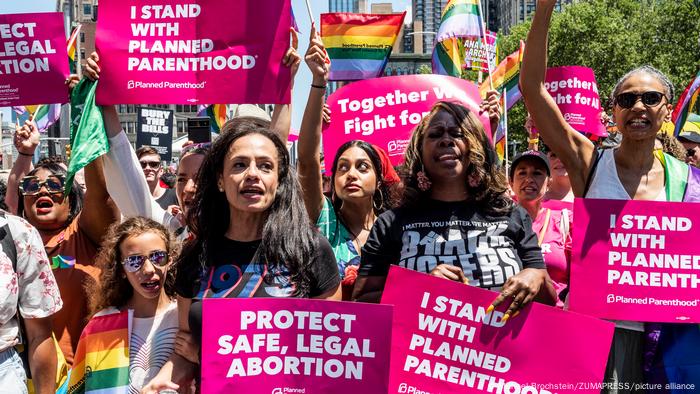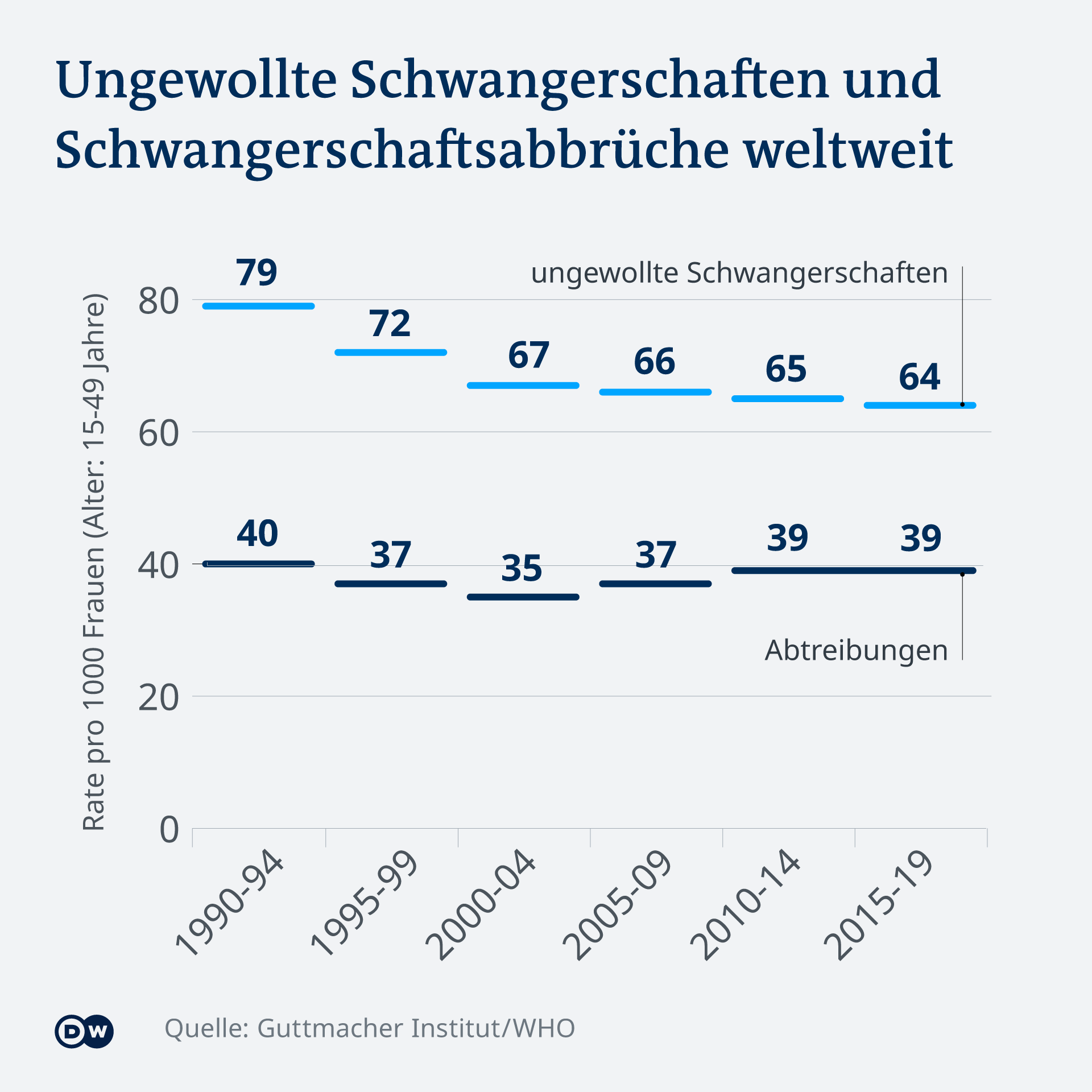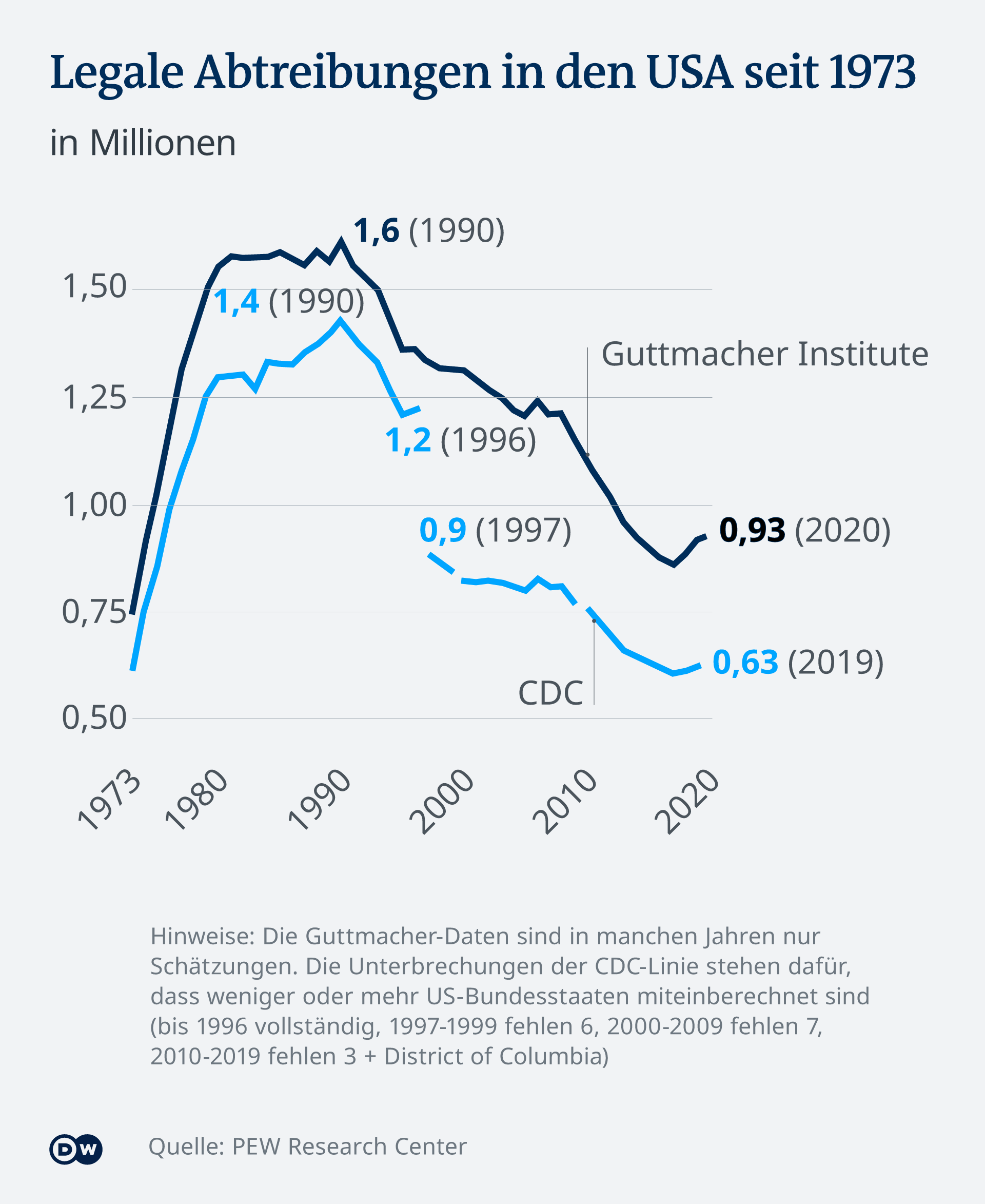Ever since the fundamental right to an abortion was overturned in the USA, abortions have been the subject of fierce debates online. But which claims by opponents and supporters are true? A fact check.

Thousands of Women protest US Supreme Court decision
Abortion is one of the health issues about which the most misinformation is currently circulating. This is the conclusion reached by researchers from the American Journal of Public Health in a study from 2021. Since then, the debate has intensified again: Both abortion opponents and proponents have been passionately discussing this, at least since the Supreme Court ruling in the USA the liberal abortion law in the country overturned – also aggressively and partly with false arguments. We checked four claims from both camps of the abortion debate.
Does a ban really stop abortions?
Claim: A ban on abortion does not prevent abortion, but leads to unsafe, sometimes life-threatening abortions, explain numerous supporters of the legalization of abortions: “The ban on abortion does not stop abortion, only safe abortion,” says a user on TikTok (here archived).
DW fact check: Correct.
A British team of researchers analyzing data from 1990 to 2019 found that abortion rates in countries that ban abortion were about the same as in countries where abortion is legal. According to this data, a ban does not lead to the absence of abortions.
The researchers evaluated numbers from 166 countries. Around the world, about every second unwanted pregnancy is terminated, with the exception of India and China. In countries where abortion is prohibited, the number of abortions is even increasing.

According to the World Health Organization (WHO), 45 percent of abortions worldwide are unsafe abortions. These are abortions that, among other things, take place without advice, are carried out by unskilled people or are carried out incorrectly or unhygienic. Especially in countries where abortion is forbidden, women who are unintentionally pregnant would also opt for unsafe abortions.
A lack of safe and respectful abortion treatment and the stigma associated with abortion endangers women's physical and mental well-being throughout their lives, according to the WHO. Unsafe abortions account for 4.7 to 13.2 percent of maternal deaths worldwide. Statistically, 30 women out of 100,000 die from unsafe abortions in developed regions, and 220 out of 100,000 women who perform abortions in developing regions. In 2012, it is estimated that seven million women in developing countries alone were treated in hospitals after suffering complications from unsafe abortions.
p>
Are there really “no safe abortions”?
Claim:Opponents of abortion and supporters of the so-called “pro-life” movement often claim that abortion of any kind endangers women's health. The anti-abortion organization “Live Action” specifically claims: “There is no such thing as a safe abortion.” (archived here)
DW fact check: False.
There are two types of legal abortion – one involves the pregnant woman taking a pill and the other involves having an operation to terminate the pregnancy in the hospital. According to the American College of Obstetricians and Gynecologists (ACOG), abortion is a common one medical procedure that is “very safe”. The organization points out that major complications from abortions are rare and only occur in 0.23 to 0.5 percent of legal abortions – regardless of the age of the pregnant woman or the type of abortion. Alicia Baier, doctor and co-founder of the organization “Doctors for Choice Germany” also confirms this. When asked by DW, the doctor confirmed that complications from abortions with a pill are extremely rare. She went on to explain that the abortion pill is being used more and more around the world and is also helping to reduce maternal mortality from unsafe abortions.
When asked by DW, Helena Lüer from the organization “Doctors Without Borders” wrote that the abortion pill was 95 percent effective and “extremely safe”. “The risk of dying from a safe abortion is lower than from a shot of penicillin or a tooth extraction,” said Lüer. Data from the US Centers for Disease Control and Prevention (CDC) also show that the mortality rate among women in the USA through abortions is very low. In the years 2013 to 2018, it was statistically less than one woman (more precisely: 0.41) in 100,000 who had an abortion.
Watch video 42:36
Abortion in Europe – despised, concealed, forbidden
Upon request, Awa Naghipour, a doctor and co-founder of the non-governmental organization Feminist Medicine, told DW that there are certain risks involved in medical and surgical abortions. The most common complications of abortion with a pill are prolonged bleeding, cramps and pain, headache, nausea and dizziness. In-hospital abortions could also damage the uterus or nearby organs. Nevertheless, the risks are much higher in regions where abortion is banned or severely restricted. “The more open, accessible, medically supervised, and standardized access to abortion, the safer it becomes,” Naghipour said.
According to the Population Reference Bureau, a US NGO, are in countries , where access to abortion is banned or restricted, only one in four abortions are considered safe. In countries where abortion is legal, nine out of 10 abortions are considered safe.
Do most Americans support strict abortion laws?
Claim: Anti-abortion advocates in the US claim that despite recent protests, most Americans would support strong legal restrictions on abortion. “71 percent of Americans support legal restrictions on abortion,” claims the Christian organization Focus on the Family on its website (archived here). She refers to a survey by the opinion research institute Marist Poll.
DW fact check: Misleading.
Listen to audio 02:34
How Europe is dealing with abortions
For the aforementioned study, 1,004 adults were interviewed by telephone in early January 2022 about their attitudes towards abortion. According to the Christian NGO Knights of Columbus, which sponsored the survey, one of the main results is that 71 percent of Americans support legal abortion restrictions.
It is worth taking a closer look at this interpretation: The respondents were presented with various statements with which they could agree or disagree. The 71 percent are made up of the following answers: 22 percent of those surveyed stated that abortion should only be allowed in the first three months of pregnancy. 28 percent said it should only be allowed in pregnancy after rape or incest and to save the mother's life. Nine percent agreed that abortion should only be allowed if the mother's life needed talking, and 12 percent said abortion should never be allowed.
These 71 percent do not show that this part of the respondents are in favor of extreme legal restrictions on abortion, only that they are in favor of abortion restrictions – and of very different kinds. But there are also hardly any advocates of legal abortions, for example who are in favor of being able to terminate a pregnancy at any time up to the ninth month.
Other studies also provide different results. A recent National Public Radio (NPR) survey of 941 adults in the United States came to the conclusion that a majority (56 percent) of those surveyed opposed the Supreme Court's decision to no longer guarantee the right to abortions in principle. 40 percent support the court's decision, four percent are unsure. So the USA is divided on this issue, the claim that there is a large majority against abortion is not based on the facts.
The number of abortions is said to be falling steadily
Assertion: “The abortion rate in the US has been falling for decades,” writes one Twitter user. To support this claim (archived here), he released statistics from the US NGO Guttmacher Institute showing that the abortion rate has been falling for almost forty years. In 1981, an average of 29.3 out of 1,000 women between the ages of 15 and 44 had an abortion – 2017 only an average of 13.5 women out of 1,000.
DW fact check:Misleading.
While the graph agrees with Guttmacher's figures, the latest data from 2019 and 2020 are missing from the graph published on Twitter. Here the abortion rate rose again slightly. In 2019, 14.2 out of 1,000 women had an abortion, in 2020 14.4.

Background: In the USA, both the Guttmacher Institute and the Centers for Disease Control publish and Prevention Abortion figures. They use different methods and come up with different numbers. For example, CDC data often does not include figures from all states. You can read more about the data search methods here.
In fact, the most recently published figures from both institutes show that the number of abortions has increased slightly in recent years. The latest CDC report counted 629,898 abortions in 2019, compared to 619,591 in 2018. Guttmacher also published figures for 2020: The researchers counted 930,160 abortions in the US, compared to 916,460 the year before.